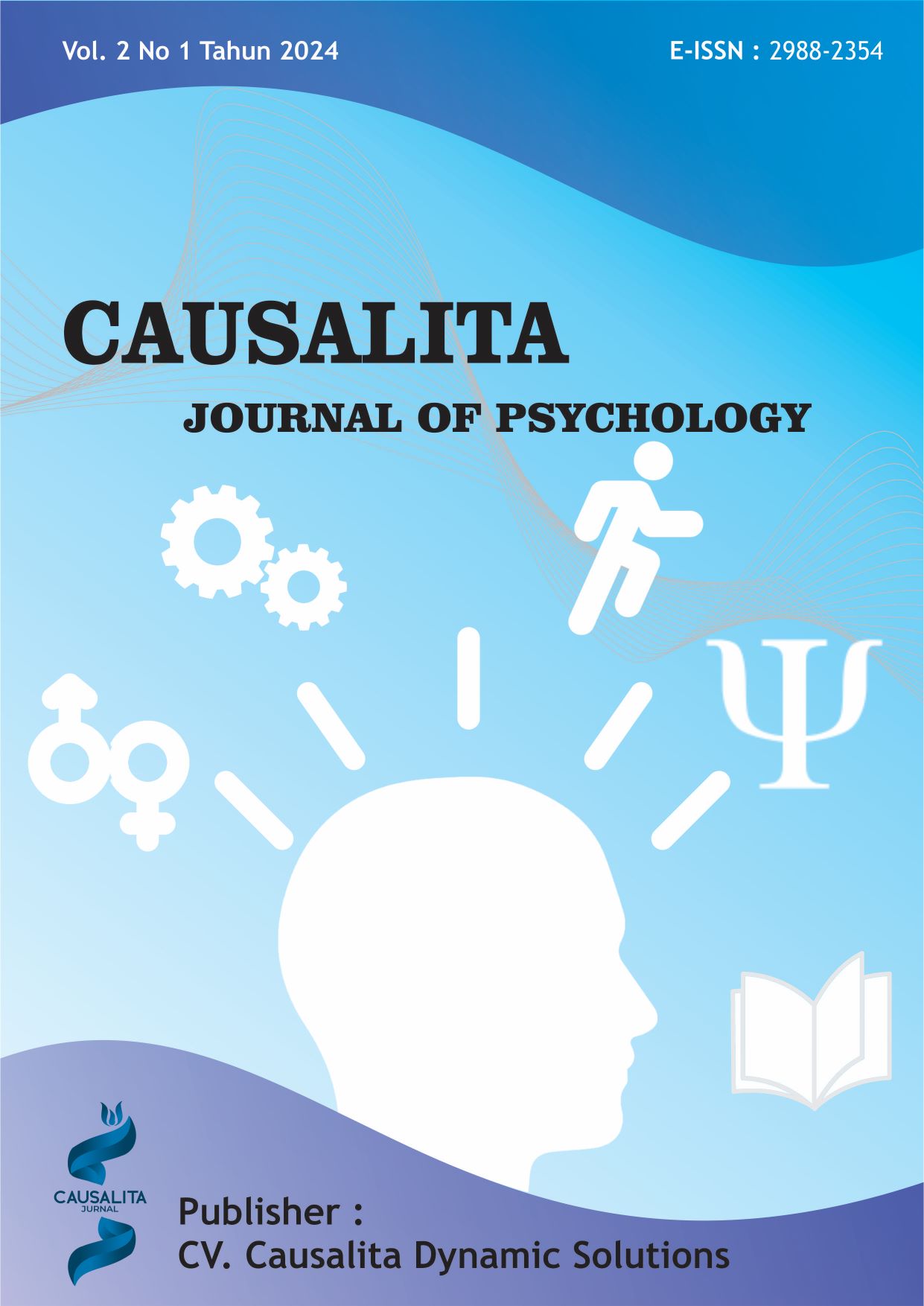The Effectiveness of Mind Mapping in Increasing English Learning Interest of Students of SMP N 1 Tilatang Kamang
DOI:
https://doi.org/10.62260/causalita.v2i1.217Keywords:
Mind mapping, early adolescence, interest in learningAbstract
This research aims to determine the effectiveness of mind mapping in increasing students' interest in learning English at SMP N 1 Tilatang Kamang. This type of research is quasi-experimental research with a pre test post test control group design. The statistical analysis technique uses the paired sample t test. The sampling technique is purposive sampling. The population in this study were students of SMP N 1 Tilatang Kamang with a sample of 8th grade students of SMP N 1 Tilatang Kamang totaling 26 people who were divided into an experimental group and a control group, each consisting of 13 people. There were three categories for sampling based on scoring. namely low, medium and high. The series of experiments was carried out for 7 days. The results of this study show that the effectiveness of using mind mapping on interest in learning English in class 8.2 students at SMP N 1 Tilatang Kamang has an effective influence in increasing interest in learning, this is based on the paired sample t test in the alpha column of 0.025 from the data table for the 12 values. t is 2.179. Therefore, it can be concluded that H0 is rejected and H1 is accepted, meaning that providing the mind mapping method can increase students' interest in learning English at SMPN 1 Tilatang Kamang.
References
Ainley, M., Hidi, S., & Berndorff, D. (2002). Interest, learning and the psychological processes that mediate their relationship. Journal of Educational Psychology, 94, 545-561.
Alviyaturrohmah, A., Saluky, S., & Muchyidin, A. (2017). Pengaruh penggunaan media pembelajaran dengan software prezi terhadap minat belajar matematika siswa. ITE} (Information Technology Engineering Journals), 2(1), 11-18.
Ananda, R.. (2019). Penerapan metode mind mapping untuk meningkatkan kemampuan berpikir kreatif siswa sekolah dasar. Edukatif: Jurnal Ilmu Pendidikan, 1(1), 1-8.
Arnaldi, M. (2014). Four factor psychologies as executive function to increase interest of learning. Procedia-Social Behavioral Science , 503-509.
Asmani J. M. (2009). Mana}emen strategis pendidikan anak usia dini, Jogjakarta: Diva Press.
Chen, W. J., & Hsiao, C. (2015). The effect of servant leadership on customer value co-creation: a cross-level analysis of key mediating roles. Tourism Management, 49, 45-57.
Diani, R., Julia, 0. N., & Rahayu, M. (2018). Efektivitas model RMS (reading, mind mapping and sharing) terhadap concept mapping skill peserta didik. Indonesian Journal of Science and Mathematics Education, 1(1), 41-48.
Faelasofi, R. (2016). Penerapan metode mind mapping pada pembelajaran matematika. Jurnal e-DuMath, 2 (2), 185-192.
Flowerdayy, T., & Shell, D. F. (2015). Disentangling The effects of interest and choice on learning, engagement, and attitude. Learning and Individual Differences, 40, 134-140.
Fryer, L. K. (2015). Predicting self concept, interest and achievement for first-year students: the seeds of lifelong learning. Learning and IndividualDifferences.
Ghozali, I. (2016). Aplikasi analisis multivariete dengan program IBM SPSS 23 (edisi 8). Semarang: Badan Penerbit Universitas Diponegoro.
Gie, T. L. (2004). Cara belajar yang baik bagi mahasiswa. Yogyakarta: Gajah Mada Pers.
Hardjana, A. M. (1994). Stres tanpa distres: seni mengolah stres. Yogyakarta: Kanisius.
Haryoko, S. (2009). Efektivitas pemanfaatan media audio visual sebagai alternatif optimalisasi model pembelajaran. Jurnal Edukasi Elektro, 5 (1), 1-10.
Hidi, S. (2006). Interest: a unique motivational variable. Educational research review, 1, 69-82.
Kriyantono, R. (2006). Teknik praktis riset komunikasi. Jakarta : PT. Kencana Perdana.
Kurniawati, E..(2021). Upaya meningkatkan minat dan hasil belajar bahasa inggris materi teks explanation melalui penerapan metode mind mapping pada siswa kelas xi-mipa-2 sma negeri 3 Bondowoso semester 2 tahun pelajaran 2017/2018. Jurnal Revolusi Pendidikan (JUREVDIK) , 4(3), 63-71.
Lutfi, M.. (2017). Penerapan metode mind mapping untuk meningkatkan minat belajar siswa mtsn Jambewangi. JPIPS : Jurnal Pendidikan Ilmu Pengetahuan Sosial, 4 (1), 14-20.
Melania Sutarni. (2011). Penerapan metode mind mapping dalam meningkatkan kemampuan mengerjakan soal cerita bilangan. Pecahan. Jurnal Pendidikan Penabur, 16(10)
Miftachurrochmah, D., & Triyono, & Chamdani. (2013). Penerapan metode peta pikiran (mind mapping) untuk peningkatan keterampilan menulis narasi siswa kelas IV sekolah dasar. Kalam Cendekia PGSD Kebumen, 4(1)
Montolalu, C., & Langi, Y. (2018). Pengaruh pelatihan dasar komputer dan teknologi informasi bagi guru-guu dengan uji t test berpasangan (paired sample t test). Jurnal Matematika dan Aplikasi, 7 (1), 44-46.
Mulyatiningsih, E. (2014). Metode penelitian terapan bidang pendidikan. Bandung: Alfabeta.
Olivia, F. (2011). Teknik ujian efektif. Jakarta: PT. Elex Media Komputindo.
Rifa'i, A., & Catharina. T. A. (2013). Psikologi pendidikan. Semarang: UNNES Press.
Rumini, S., & Sundari, S. (2004), Perkembangan anak dan remaja, Jakarta: PT. Asdi Mahasatya.
Santrock, J. W. (2007). Child development (11th Edition). Boston.: McGraw- Hill.
Schiefele, U. (2001). The role of interest in motivation and learning. in j. m. collis, & s. messick (eds.), intelligence and personality: bridging the gap in theory and measurement. Mahwah NJ: Lawrence ErlbraumAssociate.
Setyanto, A. E.. (2013). Memperkenalkan kembali metode eksperimen dalam kajian komunikasi. Jurnal Ilmu Komunikasi, 3(1), 37-48.
Sirait, E. D. (2016). Pengaruh minat belajar terhadap prestasi belajar matematika. Formatif: Jurnal Ilmiah Pendidikan MIPA, 6 (1), 35-43.
Slameto. (2010). Belajar dan faktor-faktor yang mempengaruhinya. Jakarta: PT. Rineka Cipta.
Sugiyono. (2010). Metode penelitian pendidikan pendekatan kuantitatif, kualitatif, dan R&D. Bandung: Alfabeta.
Sugiyono. (2014). Metode penelitian pendidikan pendekatan kuantitatif, kualitatif, dan R&D. Bandung: Alfabeta.
Sugiyono. (2016). Metode penelitian kuantitatif, kualitatif dan R&D. Bandung: PT Alfabet.
Suryabrata, S. (2011). Psikologi pendidikan, Jakarta: PT. Raja Grafindo Persada.
Susanto, Totok. (1998). Faktot-faktor yang mempengaruhi minat belajar. Taufani. (2008). Minat, faktor-faktor yang memengaruhi. Jakarta: Rineka Cipta.
Usman, H., & Setiady,P. (2003). Metode penelitian sosial. Jakarta : Bumi Aksara.
Wang, Z., & Adesope, 0. (2016). Exploring the effects of seductive details with the 4-phasemodel of interest. Learning and Motivation, 55, 65-77.
Widoyoko, E. P. (2014). Penilaian hasil pembelajaran di sekolah. Yogyakarta: Pustaka Pelajar.
Downloads
Published
Issue
Section
License
Copyright (c) 2024 yusi nadila Nadila, Maya Yasmin, Yanladia Yeltas Putra

This work is licensed under a Creative Commons Attribution-ShareAlike 4.0 International License.






